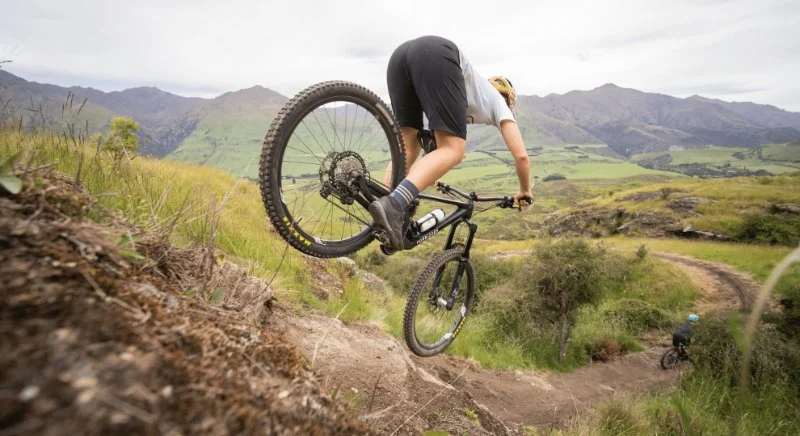
- Understanding Brake Overheating
- Techniques to Prevent Brake Burnout
- The Importance of Body Position
- Gear Selection for Steep Downhill
- Real-Life Experience: Avoiding Brake Burnout on Steep Downhills
Understanding Brake Overheating
When riding downhill, especially on steep slopes, your brakes work overtime to slow you down. This consistent pressure generates heat, which can cause your brake components to overheat. Overheated brakes can lead to reduced braking efficiency, which is dangerous, especially at high speeds. Understanding the factors that contribute to brake overheating will help you take preventive measures during your ride.
1. Friction and Heat Build-Up
When you apply the brakes, friction is created between the brake pads and the rotor (for disc brakes) or rim (for rim brakes). This friction generates heat. On a long or steep downhill, this heat can build up quickly, causing the brake fluid to boil or the pads to lose their grip. This is commonly known as brake fade.
2. Brake Fade
Brake fade occurs when the heat generated by braking causes the brake pads to become less effective. As the pads heat up, their material becomes less able to grip the rotor or rim, reducing braking power. This makes it harder to slow down or stop, putting the rider at risk. Understanding this phenomenon will help you take precautions to avoid it.
Techniques to Prevent Brake Burnout
Knowing how to prevent brake burnout is essential when cycling downhill. Below are several key techniques to help you maintain control and prevent overheating:
1. Use Intermittent Braking
Instead of continuously pressing down on the brakes, try using intermittent braking. Apply the brakes in short bursts, giving them time to cool between uses. This technique helps distribute the heat buildup, reducing the likelihood of brake fade. It’s particularly useful on long or steep descents where you need to maintain control over an extended period.
2. Use Both Brakes Efficiently
Many riders make the mistake of relying solely on the front or rear brake when descending. However, using both brakes efficiently can prevent excessive heat buildup in one part of the braking system. The front brake provides most of the stopping power, but the rear brake helps to balance the load and reduces the stress on the front brake. Using both will improve your control and prevent brake failure.
3. Apply Brake Pressure Gradually
Avoid slamming on the brakes. Instead, apply pressure gradually to avoid sudden spikes in heat. Rapidly pressing down on the brakes can cause an excessive amount of friction in a short period, leading to overheating. Smooth and controlled brake application is key for keeping your braking system cool.
4. Take Advantage of Natural Features
Look for opportunities to use the terrain to slow down rather than relying solely on your brakes. For example, riding on flat or slightly uphill sections can give your brakes a break, allowing them to cool down. Additionally, shifting your weight and using gravity to control your speed can reduce your reliance on the brakes.
The Importance of Body Position
Your body position plays a crucial role in how effectively you control your bike during a steep downhill descent. A proper body position helps you maintain balance, reduce strain on your brakes, and keep your bike stable on the slopes. Here's how to position yourself:
1. Lean Back Slightly
When riding downhill, shifting your weight slightly backward can help distribute your body weight more evenly and reduce the strain on the front brake. This position allows your rear brake to help slow you down while preventing your front wheel from lifting off the ground, which can be dangerous.
2. Keep Your Arms Loose
Loosen your grip on the handlebars and keep your arms slightly bent. A tight grip can increase your chances of losing control, especially when you need to make quick adjustments. By staying relaxed, you'll be able to react more quickly to changes in terrain and road conditions, helping you maintain better control over your bike.
3. Lower Your Center of Gravity
By lowering your body toward the bike, you improve stability and reduce the risk of flipping over. Keep your elbows bent and your knees slightly outwards. This helps you maintain balance and absorb bumps and shocks from the road, which can reduce the need for excessive braking.
Gear Selection for Steep Downhill
Choosing the right gears is essential when descending a steep hill. Riding in the wrong gear can lead to unnecessary strain on your brakes and can affect your ability to control your speed. Here's how to choose the best gear for downhill riding:
1. Shift to a Higher Gear
When descending, shifting to a higher gear allows you to maintain a controlled speed without relying too heavily on your brakes. A higher gear allows you to coast at a faster pace without the need to brake constantly. It’s important to know your bike’s gear system and shift early to maintain a comfortable cadence.
2. Use the Right Gear for Your Speed
Choose a gear that matches your speed and the steepness of the hill. If the descent is particularly steep, avoid using the highest gear, as it may be harder to control your speed. Instead, select a gear that gives you a good balance between speed and braking control, ensuring you have enough power to slow down when necessary.
Real-Life Experience: Avoiding Brake Burnout on Steep Downhills
In a real-life example, a cyclist in Colorado was riding down a steep mountain pass and noticed that their brakes were starting to overheat. The rider had been using their front brake too aggressively, causing the brakes to lose effectiveness. Recognizing the signs of brake fade, the rider switched to using intermittent braking, applying pressure to both the front and rear brakes. By adjusting their technique and body position, the cyclist was able to descend safely without fully relying on the brakes and without causing further overheating.
This experience highlights the importance of using proper braking techniques and being mindful of terrain and body position when riding down steep hills. It serves as a reminder to always be prepared and aware of how your actions affect your bike's performance.
If you're looking for high-quality cycling gear, brake components, or advice on bike maintenance, visit Cycling Guider for the best products and services tailored to your needs.







 Cardiff Vintage Bike Shop & Repair4.0 (18 reviews)
Cardiff Vintage Bike Shop & Repair4.0 (18 reviews) Phat Tire Bike Shop4.0 (286 reviews)
Phat Tire Bike Shop4.0 (286 reviews) The Bike Guy4.0 (63 reviews)
The Bike Guy4.0 (63 reviews) Pumpkinvine Cyclery4.0 (121 reviews)
Pumpkinvine Cyclery4.0 (121 reviews) Paragon Fit Studio5.0 (136 reviews)
Paragon Fit Studio5.0 (136 reviews) Sprockets Bike Shop in Tradition4.0 (170 reviews)
Sprockets Bike Shop in Tradition4.0 (170 reviews) How to Teach Kids to Ride a Bike: A Step-by-Step Guide for Parents
How to Teach Kids to Ride a Bike: A Step-by-Step Guide for Parents Tips for Riding on Busy City Streets: Smart Strategies for Urban Cyclists
Tips for Riding on Busy City Streets: Smart Strategies for Urban Cyclists Best US National Parks for Mountain Biking: Ride Epic Trails Across America
Best US National Parks for Mountain Biking: Ride Epic Trails Across America Best Aero Helmets for Time Trials and Racing
Best Aero Helmets for Time Trials and Racing How to Clean and Lubricate Your Bike Chain Like a Pro
How to Clean and Lubricate Your Bike Chain Like a Pro 10 Must-Have Items for Long-Distance Cycling Trips
10 Must-Have Items for Long-Distance Cycling Trips